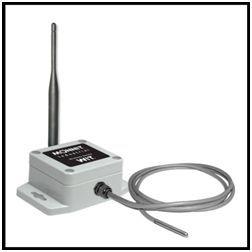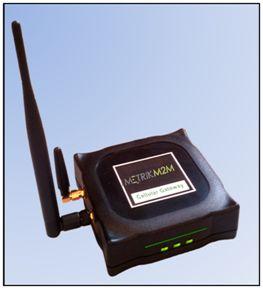A partnership deal between Monnit and iMetrik M2M is enabling a comprehensive range of innovative, plug and play solutions that deliver the requisite functionality in a matter of minutes.
 Most M2M solutions are predicated on the ability to monitor and measure parameter data. Soil contains data on moisture, salinity, pH value and density. There’s pollution data on the air we breathe. It’s literally all around us. But in many cases, there’s no mains electricity in the vicinity. Therefore, unless energy-harvesting technology can be employed, batteries must be used and in that case, sensor’s power consumption should be ultra-low.
Most M2M solutions are predicated on the ability to monitor and measure parameter data. Soil contains data on moisture, salinity, pH value and density. There’s pollution data on the air we breathe. It’s literally all around us. But in many cases, there’s no mains electricity in the vicinity. Therefore, unless energy-harvesting technology can be employed, batteries must be used and in that case, sensor’s power consumption should be ultra-low.
Today we take that scenario for granted, but go back five years and the requisite sensor modules weren’t available. The founder of Monnit, Brad Walters, and his business partner Nick Mecham had sold an earlier M2M venture to Digi International™ but they continued to watch the industry. When TI™ came out with a low-cost, low-power RF/microprocessor system on a chip (SoC) in 2008 they reasoned that what had been a gaping hole in the market could now be filled. The technology that would enable battery-powered, wireless sensors to transmit at line of sight distances of up to 900 feet (300 meters), and indoors up to 300 feet (90 meters), could be developed and that is exactly what they did. Visit the site and you will see a comprehensive, unrivaled range of RF wireless sensors.
Monnit's industrial wireless temperature sensor probes measure temperatures up to three feet or more away from the radio link. Modules are available for use in 900MHz, 868MHz and 433MHz.
THE WIRELESS SENSOR SYSTEM
Monnit’s wireless sensor system employs a regular M2M value chain. (1) Sensors are triggered or activated at set intervals. (2) Sensor information is received instantly by the gateway and sent to an online system. (3) The online system receives sensor information then checks against pre-set thresholds and if needed it sends an alert. (4) Users receive email and/or text alerts if thresholds are met and are able to respond to incident immediately. They can also set the thresholds via Web-based application.

The wireless gateways were, and still are, an Ethernet, and PC USB device, but this approach has obvious physical limitations. Nevertheless Monnit has been very successful with their sensor systems. Back in 2008, the same RF hole in the market applied to wireless gateways, i.e. products that had RF inputs, a cellular output interface with low price points were not available.
NOW IT GETS INTERESTING
Around 2010/11 it became apparent that a wireless gateway having the right functionality and price would allow the company to address a wide range of new market segments: scenarios where it would not make sense to deploy a PC. To take a simple example, monitor water levels in household basements and start the sump pump when there is a potential problem and stop the pump when it has been resolved. In addition, the solution makes periodic checks to make sure that the pump is functioning correctly, e.g. ensure that the backup battery is charged and that there is power from the grid. If there is an issue then both the homeowner and the installer are informed, which allows the latter to react promptly and avert a potential flooding problem.
The company’s principals looked around and didn’t find what they wanted so they asked iMetrik M2M to develop a cellular gateway. At first sight this might appear to be a somewhat curious decision, as the company didn’t market any M2M hardware at the time. But what they did have was a contractual agreement with iMetrik Global, whose network provides instant access in over 120 countries through 170 GSM operators. Both companies use the same NOC (Network Operating Center) for connectivity.
The cellular gateway also acts as a concentrator. Depending on the frequency of check-in it can accommodate up to 100 sensors. In addition there is a software-based location position service.
 iMetrik M2M was therefore able to design a quad-band GSM 2.5G gateway that not only met Monnit’s specification, but also could be shipped pre-activated on the network, thereby enabling solutions to be used right out of the box. There is no need to negotiate mobile operator connectivity contracts.
iMetrik M2M was therefore able to design a quad-band GSM 2.5G gateway that not only met Monnit’s specification, but also could be shipped pre-activated on the network, thereby enabling solutions to be used right out of the box. There is no need to negotiate mobile operator connectivity contracts.
Terms like “plug and play” and “out of the box” have become over-used, OTT marketing clichés that didn’t deliver an immediate, end-user experience. The Monnit/iMetrik M2M solution, which both companies market and support, kicks in as soon as the sensor module’s RF signal is received by the gateway. The application starts and is up and running when the user sets the alarm limits. It really is that simple.
THE BUSINESS MODEL
These low-cost, easy-to-implement solutions combine local area RF technology with wide area cellular, making them ideal for numerous industrial and personal applications: too numerous to list. The wireless sensor kits and monitoring software can be ordered on line, as can the cellular gateway. There is a low monthly connectivity charge: no hidden fees; no activations fee; no roaming charges and no MVNO contract is required. This unique feature that comes from the fact that the iMetrik Global network uses its own SIM cards and has its own HLR (Home Locations Register).
CONCLUSIONS
The combination of local area network RF technology and wide area cellular is enabling a comprehensive range of pragmatic, no-brainer solutions. Monnit is the market leader in low-cost, low-energy wireless sensors and iMetrik M2M has developed a gateway that leverages the functionality of those devices. For example, solutions can be deployed around the world in a matter of minutes. The gateway comes pre-activated on the iMetrik global network and there is no need to negotiate mobile operator connectivity contracts. In a nutshell, it’s a one-stop shop, out-of-the-box monitoring offer.
Edited by
Rich Steeves





